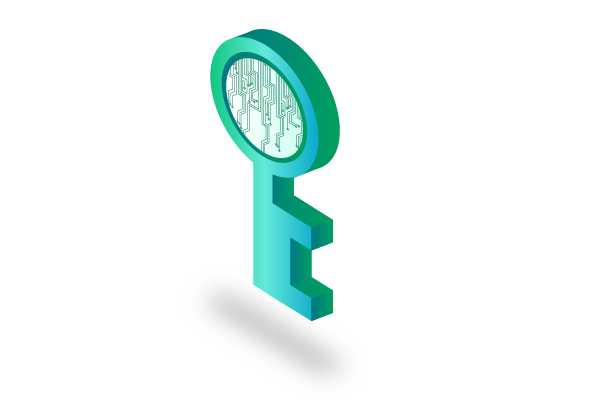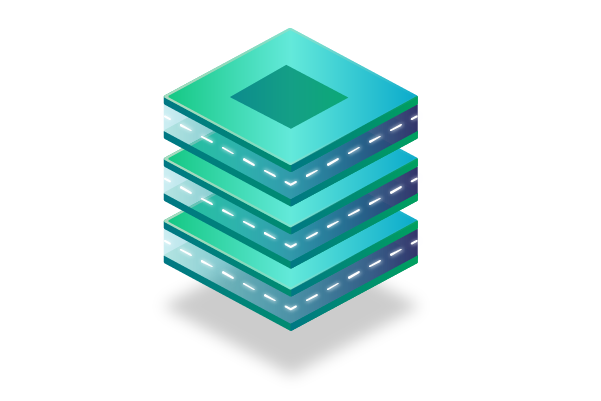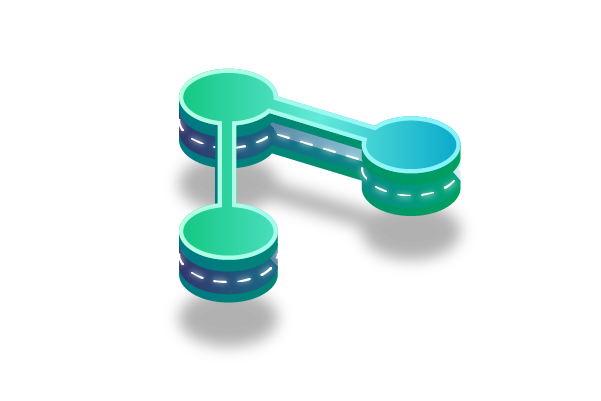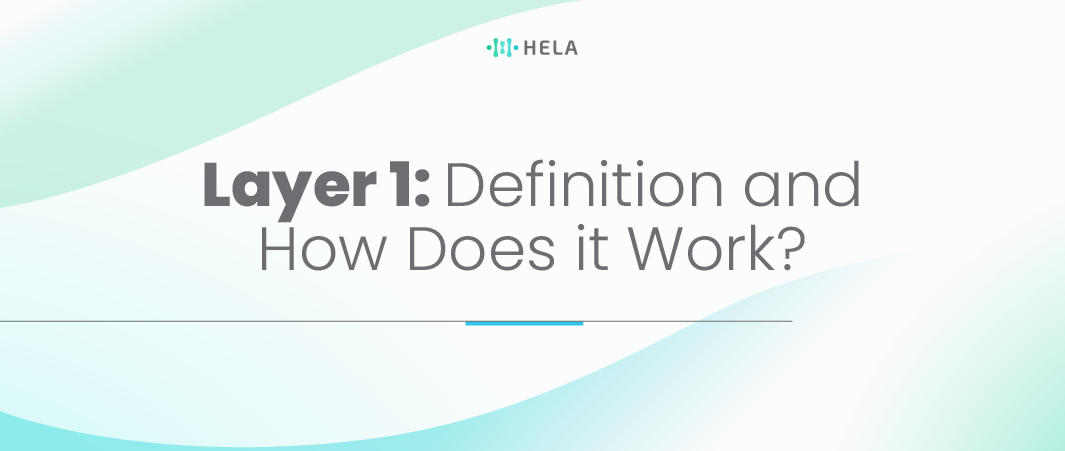In the vast, complex landscape of computer networking and blockchain technology, “Layer 1” is a term that often surfaces. But what does it mean, and why is it crucial? Layer 1 refers to the base protocol or foundational layer of a technology stack, and it has significant implications, especially in the fields of computer networking and blockchain.
Understanding Layer 1 is paramount for those in the tech sector, particularly as the digital era continues its rapid progression. In this article, we’ll explore the definition of Layer 1, its core principles, and its functions in different technology contexts.
What is Layer 1 ?

Layer 1, often abbreviated as L1, refers to the primary, base-level chain in a blockchain network. It provides the most fundamental services, such as recording transactions on the public ledger and ensuring robust security. While various L1 chains tackle the challenges of constructing blockchain networks in diverse ways, they all have foundational elements that enable the myriad functions of cryptocurrency—from serving as a currency to powering decentralized applications and more.
Bitcoin, the pioneer of the crypto world, was the first Layer 1 blockchain. Interestingly, it wasn’t labeled as “L1” initially since it was the sole layer in existence. However, with Ethereum’s introduction, blockchain technology began to power smart contracts. As these platforms gained traction, it became evident that individual blockchains might struggle with scalability or efficiently managing increased usage. This realization led to the development of scaling solutions built atop these foundational layers.
Layer 1 Scaling
Layer 1 scaling is a fundamental concept in the world of blockchain technology, primarily aimed at enhancing the performance and scalability of blockchain networks at their core layer. At this foundational layer, various blockchains, such as Bitcoin and Ethereum, process and validate transactions. The term “layer 1” refers to the base layer or the main blockchain protocol, which includes elements like consensus mechanisms, data structures, and the network’s architecture.
The need for layer 1 scaling arises from the inherent limitations of many blockchain networks. Traditional blockchains, like Bitcoin and Ethereum, have encountered challenges related to scalability, causing slow transaction speeds and high fees during periods of network congestion. Layer 1 scaling solutions seek to address these issues directly within the blockchain’s protocol itself.
Also Read : Top 15 Layer 2 (L2) Crypto List to Consider in 2023
One of the most discussed approaches to layer 1 scaling is the development and implementation of novel consensus mechanisms. For example, Bitcoin employs the Proof of Work (PoW) consensus, which has its limitations, such as energy consumption and scalability concerns. Layer 1 scaling initiatives explore the implementation of alternative consensus mechanisms, like Proof of Stake (PoS) and Proof of Authority (PoA), to enhance transaction throughput and efficiency.
Furthermore, sharding, a technique that divides the blockchain into smaller, manageable segments (shards), is another promising layer 1 scaling solution. Sharding allows for parallel processing of transactions across different segments of the blockchain, significantly increasing the network’s capacity to handle transactions and smart contracts.
Interoperability is another key consideration in layer 1 scaling. Blockchain networks often operate in isolation, limiting their usefulness. To address this, layer 1 scaling initiatives aim to establish cross-chain compatibility, enabling seamless data and asset transfer between different blockchains.
The Limitations of Layer 1
The emergence of second-layer solutions, such as the Lightning Network for Bitcoin and the proposed Ethereum 2.0 upgrade, have sought to address scalability issues while maintaining a degree of decentralization and security. These solutions aim to offload some transactional burden from the main chain, enabling faster and more cost-effective transactions. Additionally, various projects have explored alternative consensus mechanisms, like Proof-of-Stake (PoS), to achieve higher scalability without compromising security or decentralization.
Despite these advancements, the blockchain trilemma remains a persistent challenge in the industry. As the demand for decentralized applications and cryptocurrencies continues to grow, striking the right balance between these three fundamental pillars becomes ever more crucial. The ongoing research and development in blockchain technology hold the promise of overcoming the trilemma and unlocking new possibilities for the future of decentralized systems, making them more accessible, secure, and efficient for a wide range of use cases beyond traditional finance and into domains like supply chain management, healthcare, and governance.
How Does Layer 1 Operate in Different Contexts?
Layer 1 refers to the first layer in various systems or models, and its specific operation can vary significantly depending on the context in which it is being used. Here are a few different contexts in which Layer 1 might operate:
1. Computer Networking
The Physical Layer’s significance lies in its responsibility for the actual transmission of data over the network medium. It handles tasks like encoding, modulation, and signaling, which are crucial in converting digital data into electrical or optical signals that can traverse the physical network medium. Additionally, the layer deals with issues such as signal attenuation, noise, and signal distortion, working to maintain the integrity and quality of data transmission across the network.
Moreover, the Physical Layer encompasses various hardware components, such as network interface cards, cables, connectors, repeaters, and switches. Each of these elements plays a vital role in facilitating data transfer and ensuring seamless communication between devices. While the OSI model is a conceptual framework, the Physical Layer’s tangible hardware aspects make it a fundamental building block for establishing reliable and efficient networks. Overall, by focusing on the essential task of transporting data as raw bits, the Physical Layer serves as a critical foundation for the entire OSI model and enables the successful functioning of higher network layers responsible for data manipulation, addressing, and routing.
2. Blockchain
Blockchain technology has fundamentally transformed various industries by providing a decentralized and immutable ledger system. At its core, Layer 1 focuses on the consensus mechanism, a critical process that guarantees agreement among all network participants about the validity of transactions and the state of the blockchain. In the case of Proof of Work, like in Bitcoin, participants compete to solve complex mathematical puzzles, expending computational power to validate transactions and create new blocks.
On the other hand, Proof of Stake allows participants to validate blocks and be rewarded based on the number of coins they hold and are willing to “stake” as collateral. This distinction showcases the diverse approaches to achieving consensus and highlights how crucial it is for the security and reliability of the blockchain network. As blockchain technology continues to evolve, further research and development in consensus mechanisms aim to address scalability, energy efficiency, and security concerns, ultimately unlocking new possibilities for decentralized applications and the broader adoption of blockchain solutions.
3. Telecommunications
In modern telecommunication networks, Layer 1 serves as the fundamental physical foundation for data transmission. This layer involves the conversion of raw data into electrical, optical, or electromagnetic signals, depending on the transmission medium used. For instance, in wired systems, Layer 1 is concerned with converting digital data into electrical signals for transmission through copper cables, while in wireless systems, it involves transforming data into radio waves for wireless propagation.
The integrity of Layer 1 is crucial as any disruptions or distortions at this level can severely impact the overall quality and reliability of communication. Engineers and technicians working with Layer 1 technologies must ensure that signals are transmitted with minimal loss, noise, and interference, to maintain seamless and efficient data transfer throughout the network.
While the specifics might vary based on the technology or industry in question, the underlying principle remains the same: Layer 1 is about establishing and maintaining a reliable and effective communication or transmission medium.
Key Components of Layer 1 in Blockchains

L1 blockchains, also known as layer-one blockchains, are the foundational layer of blockchain networks. They serve as the base layer upon which various decentralized applications (dApps) and smart contracts are built. Layer 1 blockchains are designed to provide secure, transparent, and immutable data storage while enabling decentralized consensus mechanisms. Here, we’ll delve into the key components that make up L1 blockchains:
1. Block Production
In the world of decentralized finance (DeFi), blockchain technology plays a pivotal role in ensuring transparent and secure transactions. Miners or validators, utilizing computational power, work to generate blocks on the Layer1 chain. These blocks, interconnected through references to earlier ones, store crucial data about new transactions, thereby creating an immutable and publicly accessible ledger called the blockchain. As the popularity of DeFi continues to soar, the robustness of blockchain’s underlying architecture becomes even more vital in sustaining the trust of participants and promoting the widespread adoption of this transformative technology.
2. Transaction Finality
The concept of irreversibility in blockchain transactions is fundamental to the technology’s security and trustworthiness. Once a transaction is included in a block and added to the blockchain, it becomes nearly impossible to alter or reverse. This assurance is achieved through cryptographic principles and consensus mechanisms that require a majority of network participants to agree on the validity of the transaction.
The time it takes for a transaction to reach this irrevocable state can differ across blockchains, depending on factors such as block confirmation times, consensus algorithms, and network congestion. Some blockchains may require several confirmations before considering a transaction irreversible, ensuring a higher level of confidence in the transaction’s validity.
Also Read : 5 Top Layer 1 (L1) Cryptocurrencies To Watch in 2023
3. Native Assets
Cryptocurrencies, such as Bitcoin (BTC) and Ethereum (ETH), play a fundamental role in enabling transactions and incentivizing miners/validators within the first layer (L1) blockchains. These digital coins serve as a medium of exchange and store of value within their respective networks. On the other hand, tokens operate as the lifeblood of decentralized applications and networks built on top of L1 blockchains.
These tokens often represent assets or utility within specific ecosystems, providing users with access to services, voting rights, or other functionalities within the decentralized platforms. While coins function as the backbone of L1 chains, tokens empower a diverse range of decentralized projects and innovations, fostering a dynamic and rapidly evolving crypto landscape.
4. Security
Indeed, L1 (Layer 1) blockchains play a pivotal role in establishing the foundational security parameters for a network. These critical aspects encompass the consensus mechanism, which determines how nodes agree on the state of the blockchain and validate transactions. Examples of popular consensus mechanisms are Proof of Work (PoW) and Proof of Stake (PoS).
PoW requires miners to compete to solve complex mathematical puzzles to add blocks to the chain, while PoS relies on validators who are chosen to validate transactions based on the number of coins they “stake” or lock up as collateral. Additionally, L1 chains define the rules governing how these validators interact, such as determining how new blocks are proposed, how conflicts are resolved, and how rewards and penalties are distributed. By setting these security parameters, L1 blockchains establish a robust and trustworthy foundation for decentralized networks to operate efficiently and securely.
Layer 1 vs. Layer 2

Due to L1’s inherent limitations, developers have explored architectural enhancements both below (Layer 0) and above (Layers 2 and 3) the L1 chain.
Layer 1 vs. Layer 2
Layer 2 (L2) solutions play a crucial role in improving the capabilities of Layer 1 (L1) blockchains, particularly when it comes to enhancing scalability. These L2 solutions function on top of existing L1 chains, requiring bridges to facilitate asset transfers between the layers. Often, L2 solutions act as independent blockchains, benefiting from the security and stability provided by their parent L1 chain. By leveraging this architecture, L2 solutions help alleviate network congestion and reduce transaction costs, making them a promising avenue for scaling blockchain technology and expanding its practical applications.
Other Layers
Layer 0 serves as the foundation of the crypto ecosystem, encompassing the entire crypto community, including developers, users, miners, and other participants. It represents the collective trust and cooperation within this community that underpins the functioning of blockchain networks. Layer 3, on the other hand, is dedicated to blockchain interoperability, providing the necessary protocols and mechanisms for different blockchains to communicate and interact seamlessly. By enabling interoperability, Layer 3 solutions aim to break down barriers between disparate blockchain networks, fostering greater collaboration, data sharing, and the expansion of decentralized applications across the broader blockchain landscape.
Top List of Layer 1 in Blockchains

The world of blockchain technology is marked by constant innovation and evolution, with Layer 1 blockchains serving as the bedrock of decentralized ecosystems. Join us as we delve into the top 7 Layer 1 blockchains that are reshaping the future of decentralized applications and digital transactions.
1. Hela Labs
Setting the Standard At the pinnacle of our list is Hela Labs, a trailblazer renowned for its groundbreaking advancements in blockchain technology. With a focus on security, speed, and scalability, Hela Labs has earned its position as the number one Layer 1 blockchain. Its commitment to pushing the boundaries of what is possible has established it as a force to be reckoned with in the ever-expanding blockchain landscape.
2. Ethereum
The Evolution Continues Ethereum, a household name in the blockchain space, takes the second spot with its transformative Ethereum 2.0 upgrade. This iteration introduces the proof-of-stake consensus mechanism, addressing scalability concerns and opening up new possibilities for decentralized applications. Ethereum’s extensive developer community and robust ecosystem contribute to its enduring significance.
3. Binance Smart Chain
Uniting Centralized and Decentralized Finance Binance Smart Chain (BSC) secures the third position, excelling in providing a seamless bridge between centralized and decentralized finance. With low transaction fees and rapid confirmation times, BSC has become a preferred choice for developers seeking efficiency without compromising decentralization.
4. Polkadot
Fostering Interoperability In the fourth spot, Polkadot stands out for its innovative approach to interoperability. The platform’s parachain architecture facilitates communication between different blockchains, paving the way for cross-chain collaboration and scalability. Polkadot’s governance model and adaptability contribute to its growing influence.
5. Solana
Accelerating Transactions Solana claims the fifth spot with its emphasis on high-speed transaction processing and low fees. Known for its impressive throughput, Solana has gained popularity among developers building decentralized applications that require swift and efficient transactions.
6. Cardano
A Paradigm of Sustainability Cardano takes the sixth position, known for its focus on sustainability, scalability, and interoperability. With a commitment to research-driven development, Cardano aims to provide a secure and scalable foundation for the future of decentralized finance and applications.
7. Avalanche
Avalanche Consensus in Action Closing our list is Avalanche, showcasing its unique consensus mechanism known as Avalanche. Offering high throughput and sub-second finality, Avalanche provides a platform for developers to build decentralized applications with a focus on security and speed.
Conclusion
Layer 1, while perhaps not as discussed as some more superficial layers, is fundamental to the digital world’s effective and secure functioning. Whether we’re talking about the transmission of a simple text message, the validation of a cryptocurrency transaction, or the broadcast of a live television show, it all starts at this foundational layer.
As we move further into the digital age, appreciating the nuances and significance of Layer 1 becomes even more critical. As technology continues its relentless march forward, one thing remains constant: the need for a reliable, efficient, and secure base layer. And that’s where Layer 1 shines the brightest.

Hi, I'm Carina, and I've been captivated by the world of web3 for as long as I can remember. Ever since I first dipped my toes into this innovative technology, I've found myself drawn to exploring and understanding its infinite potential. The complexities of layer 1 solutions particularly intrigue me, as they form the foundation of decentralized networks and pave the way for a more transparent and efficient digital landscape.
-
Carina Caringalhttps://helalabs.com/blog/author/carina-caringal/
-
Carina Caringalhttps://helalabs.com/blog/author/carina-caringal/
-
Carina Caringalhttps://helalabs.com/blog/author/carina-caringal/
-
Carina Caringalhttps://helalabs.com/blog/author/carina-caringal/

